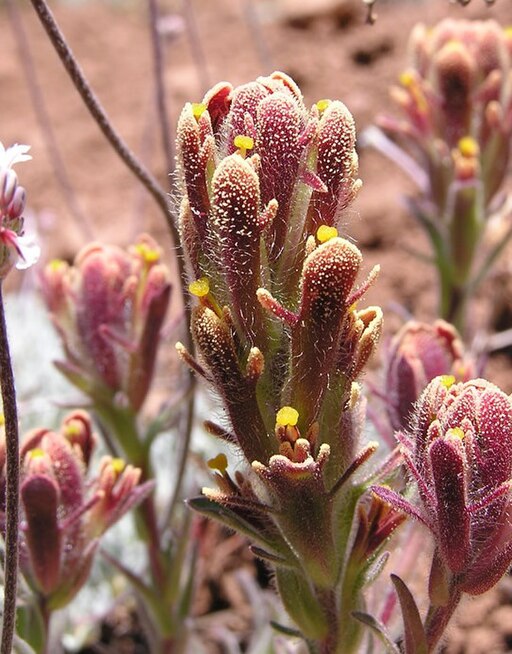Classification System: APG IV
Superregnum: Eukaryota
Regnum: Plantae
Cladus: Angiosperms
Cladus: Eudicots
Cladus: Core eudicots
Cladus: Asterids
Cladus: Lamiids
Ordo: Lamiales
Familia: Orobanchaceae
Tribus: Pedicularideae
Genus: Castilleja
Species: Castilleja cinerea
Name
Castilleja cinerea A.Gray
Synonyms
Orthocarpus cinereus (A. Gray) Jeps.
Distribution
It is endemic to San Bernardino County, California, where it is known only from the San Bernardino Mountains.
References
Proceedings of the American Academy of Arts and Sciences. Boston, MA 19:93. 1883
Links
International Plant Names Index. 2017. Castilleja cinerea. Published online. Accessed: Oct. 04 2017.
The Plant List 2013. Castilleja cinerea in The Plant List Version 1.1. Published online. Accessed: 2017 Oct. 04.
Tropicos.org 2017. Castilleja cinerea. Missouri Botanical Garden. Published online. Accessed: O4 Oct. 2017.
USDA, ARS, Germplasm Resources Information Network. Castilleja cinerea in the Germplasm Resources Information Network (GRIN), U.S. Department of Agriculture Agricultural Research Service. Accessed: 09-Oct-10.
Vernacular names
English: ashgray Indian paintbrush
Castilleja cinerea is a species of Indian paintbrush known by the common name ashgray Indian paintbrush. It is endemic to San Bernardino County, California, where it is known only from the San Bernardino Mountains. There are about 20 occurrences known.[1]
Description
This is a perennial herb growing up to 15 centimeters tall and covered in a coat of ash-gray woolly hairs. The leaves are linear or narrowly lance-shaped and one or two centimeters long. The inflorescence is made up of fuzzy dull to bright reddish or purplish pink bracts between which emerge smaller yellowish to greenish flowers. The color of the inflorescence is influenced by the environment of the plant; those with more northern exposures tend to have yellowish flowers and those facing south have more reddish flowers.[2]
Like other Castilleja species, this plant parasitizes other species for water and nutrients; C. cinerea is generally found tapping buckwheats (Eriogonum spp.) and sagebrushes (Artemisia spp.).[2]
Habitat
Castilleja cinerea grows in several habitat types, including dry desert and sagebrush scrub, woodland, and coniferous forest. It is also known from the unique quartzite pebble plain habitat in these mountains, which it shares with other endemics such as Arenaria ursina.[2]
Threats
The Castilleja cinerea plant is a federally listed threatened species. Threats to its survival include development of its habitat for human use, recreation, off-road vehicles, logging, grazing, mining, and invasive species of plants.[1][3]
References
The Nature Conservancy
Forest Service Fire Ecology
California Native Plants Inventory
Retrieved from "http://en.wikipedia.org/"
All text is available under the terms of the GNU Free Documentation License


